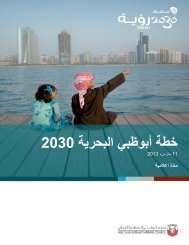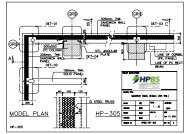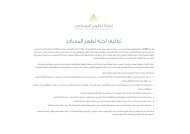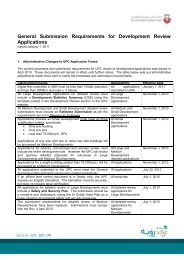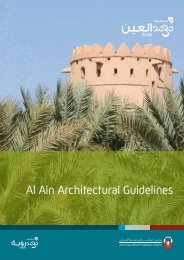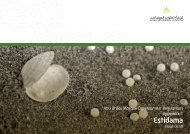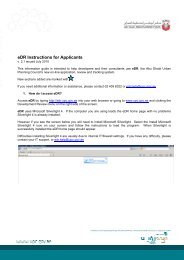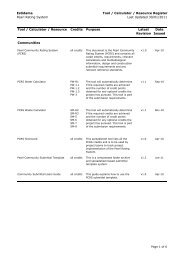Design
Design
Design
Create successful ePaper yourself
Turn your PDF publications into a flip-book with our unique Google optimized e-Paper software.
Abu Dhabi Mosque Development Regulations<br />
Volume 2 - <strong>Design</strong><br />
STAGE 1<br />
Policies and Principles<br />
STAGE 2<br />
Architecture<br />
STAGE 3<br />
Building Services<br />
STAGE 4<br />
Landscape<br />
3.0 Site Development<br />
The Site Development Standards relate to the spatial<br />
layout of all functional components within the mosque<br />
plot. They ensure the mosque is prominent, visible and<br />
encourages safety through design by considering the<br />
following:<br />
• the relationship of a mosque to its context;<br />
• access to and from the mosque plot; and<br />
• the placement and arrangement of functional<br />
components to each other.<br />
Methodology<br />
i. Use the built form parameters from the Mosque<br />
Planning Summary Sheet, as completed through the<br />
use of Volume 1 - Planning.<br />
ii. Utilise the opportunities and mitigate the constraints<br />
of the site and its surroundings with respect to the<br />
following (but not limited to):<br />
• existing natural systems;<br />
• microclimate;<br />
• pedestrian and vehicular connectivity;<br />
Outcome<br />
i. A spatial layout is created that identifies public,<br />
private and restricted areas that relates to its site and<br />
context.<br />
ii. The progressional relationship of vernacular<br />
components are clearly identified.<br />
iii. Safety considerations are integrated in the spatial<br />
layout.<br />
iv. On-site parking considerations are integrated in the<br />
spatial layout.<br />
• linkages to community facilities; and<br />
Vernacular Components<br />
v<br />
• surrounding built form.<br />
iii. Adapt the specific Mosque Circulation Diagram,<br />
prepared in Section 2.4, to create a spatial layout<br />
that relates to the site and its surrounding context,<br />
based on the Site Development standards.<br />
iv. Ensure the vernacular components are identifiable<br />
and prominently placed in the spatial layout.<br />
v. Meet all minimum standards as per the requirements<br />
of the relevant authorities.<br />
Further to the guidance on Emirati mosque<br />
vernacular architecture provided in Section VI,<br />
the vernacular mosque has a specific spatial<br />
sequence. The worshipper enters the mosque<br />
plot via the portal. Entering through the portal<br />
represents the transition between everyday life<br />
into a spiritual environment. The portal leads to<br />
a defined sahan, followed by the riwaq, into the<br />
prayer hall and finally, the worshipper faces the<br />
mihrab.<br />
These architectural elements, forming the<br />
spine of spatial progression, are the ‘vernacular<br />
components’ of Emirati mosques.<br />
Architecture - Page 19



